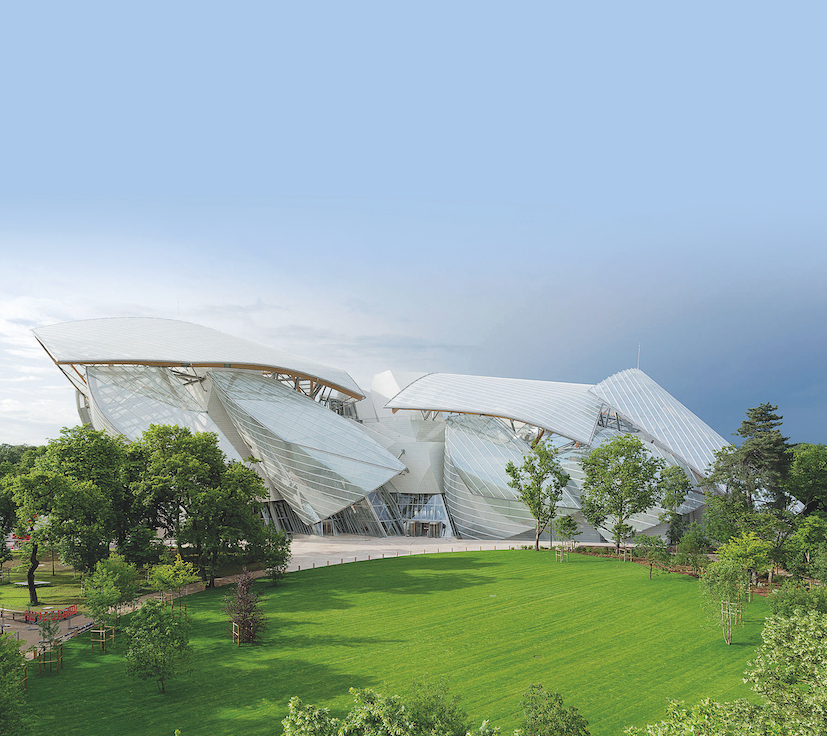Originally published December 2020.
Frank Gehry’s cultural centre in the Bois de Boulogne was born into controversy but is now accepted as a phenomenal piece of architecture whose structural gymnastics defy belief.
La Fondation Louis Vuitton, a remarkable building by any standard, was designed by the illustrious Frank Gehry. The architect was invited by Bernard Arnault, chairman of LVMH, to consider designing an art museum for the Louis Vuitton Foundation for Creation on the edge of the Bois de Boulogne in Paris, and the project was first presented in 2006 with a cost estimate of around €100m. The City of Paris, which owned the park, granted a building permit in 2007.
But in 2011 an association for the safeguarding of the Bois de Boulogne won a court battle against the project, with the judge determining it too close to a tiny asphalt road that was deemed a public right of way. The City appealed and the museum was ruled to be in the national interest; legislation was passed allowing construction to proceed on the basis that it would become “a major work of art for the whole world”. The centre opened to the public in October 2014 at a reported cost of $143m – though three years later the true cost was revealed to have been nearer $900m.
Upon Arnault’s invitation, Frank Gehry had visited the garden, and imagined an architecture inspired by the glass Grand Palais. When I went to see the museum in 2015, I was taken aback by the complexity of the structure, which appeared somewhat as a geometrical solution to Gehry’s quite amazing designs. The two-storey structure has 11 galleries totalling some 41,000 sq. ft, a voluminous 350-seat auditorium and multiple roof terraces for events and art installations.

The 126,000 sq. ft project required innovative technological development with the use of a specialised 3D design software, ‘Digital Project’, which was originally created for the aviation industry. The resulting glass building takes the form of a yacht’s sails inflated by the wind. These glass sails envelop the ‘iceberg’, a series of shapes with white flowery terraces. The visual impact to any first-time visitor like myself is quite honestly awe-inspiring and contains an overall beauty that is a joy to behold.
Among the most amazing features of the whole complex are the glass sails, made of 3,584 laminated glass panels that are each unique and specifically curved to fit the shapes drawn by Gehry. The galleries are covered externally in a white fibre-reinforced concrete called Ductal, with some 19,000 concrete panels involved in its construction.
Among the most amazing features of the whole complex are the glass sails, made of 3,584 laminated glass panels that are each unique and specifically curved to fit the shapes drawn by Gehry
Quite frankly (pun intended), it is not difficult to appreciate why the budget on this extraordinary project soared out of control. But more important than the cost is the total uniqueness of this fabulous building. It is simply the best of modern architecture combined with a strategic technology that enabled it to be built. Although it originally caused controversy and attracted criticism from local residents, it became accepted as a phenomenal piece of architecture involving structural gymnastics that defy belief.
One of the most beautiful features of the whole complex is the landscaped water garden, which flows not only outside but also through the building. This was brilliantly conceived and creates a calming influence that resonates with all the wonderful art and architecture it surrounds. The structure and shapes of the roof and sails allow rainwater to be recovered, stored and filtered so it can be used in cleaning and watering the plants.
Fondation Louis Vuitton is a monument to 21st-century architecture; it is a masterpiece by a master architect and its success can be summed up by something Picasso once said: “Art wipes the soul clean of the dust of everyday life. A cleansed soul restores enthusiasm and is what all future generations need most.” This statement is a particularly fitting tribute that applies admirably to Frank Gehry’s incredible vision for this very special piece of architecture.










